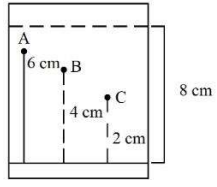Three organic compounds A,B and C were allowed to run in thin layer chromatography using hexane and gave the following result (see figure). The Rf value of the most poar compound is _____×10−2

Step by step video solution for Three organic compounds A,B and C were allowed to run in thin layer chromatography using hexane and gave the following result (see figure). The R_(f) value of the most poar compound is _____times 10^(-2) by Chemistry experts to help you in doubts & scoring excellent marks in Class 12 exams.
Topper's Solved these Questions
Similar Questions
Three compounds A, B, and C are isomers of the formula C5H8. All of them decolourise bromine in CCl4 and give a positive test with Baeyer's reagent. All three compounds dissolve in cone. H2SO4. Compound A gives a white precipitate with ammoniacal silver nitrate, whereas compounds B and C do not react with it. On hydrogenation, in the presence of platinum catalyst, both compounds A and B yield n-pentane, whereas compound C gives a product of formula C5H10. On oxidation with hot acidified KMnO4, B gave acetic acid and CH3CH2COOH. Identify compounds A, B, and C.
View SolutionAn organic compound containing C, H, N and O gave the following results on analysis :
(i) 0.25 g of the compound gave 0.368 g of CO2 and 0.205 g of H2O
(ii) The same weight of the compound gave 31.2 mL of N2 at S.T.P.
Calculate the percentage composition of the compound.View Solution
Knowledge Check
- Question 1 - Select One
10 " mL of " a gaseous organic compound containing C, H and O only was mixed with 100 " mL of " O2 and exploded under condition which allowed the H2O formed to condense. The volume of the gas after explosion was 90 mL. On treatment with KOH solution, a further contraction of 20 mL in volume was observed. The vapour density of the compound is 23. All volume measurements were made under the same condition.
Q.The molecular formula of the compound isAC3H8OBC3H6OCC2H6ODC2H4O - Question 2 - Select One
10 " mL of " a gaseous organic compound containing C, H and O only was mixed with 100 " mL of " O2 and exploded under condition which allowed the H2O formed to condense. The volume of the gas after explosion was 90 mL. On treatment with KOH solution, a further contraction of 20 mL in volume was observed. The vapour density of the compound is 23. All volume measurements were made under the same condition.
Q.The volume of CO2 isA20 mLB50 mLC70 mLD90 mL - Question 3 - Select One
10 " mL of " a gaseous organic compound containing C, H and O only was mixed with 100 " mL of " O2 and exploded under condition which allowed the H2O formed to condense. The volume of the gas after explosion was 90 mL. On treatment with KOH solution, a further contraction of 20 mL in volume was observed. The vapour density of the compound is 23. All volume measurements were made under the same condition.
Q.The volume of unreacted O2 isA20 mLB50 mLC70 mLD90 mL
An organic compound A containing C = 70% and H =11.6% gave the following results :
(P) 0.384 gm of the compound A displaced 100 ml of air at 1 atm and 273 K.
(Q) On treatment with PCl3A gave another compound, which contained 33.97%(34%)chlorine.
An ismor of it B gave compound C containing 50.35% chlorine with PCl5.C gives back B with aq. KOH correct structure of B is:View SolutionAn organic compound A containing C = 70% and H =11.6% gave the following results :
(P) 0.384 gm of the compound A displaced 100 ml of air at 1 atm and 273 K.
(Q) On treatment with PCl3A gave another compound, which contained 33.97%(34%)chlorine.
An ismor of A and B which gives two organic product with PCl5 is :View SolutionCompounds 'A' and 'B' react according to the following chemical equation
A(g)+2B(g)→2C(g)
Concentration of either 'A' or 'B' were changed keeping the concentrations of one of the reactants constant and rates were measured as a function of initial concentration. Following results were obtained. Choose the correct option for the rate of equations for this reaction.
 View Solution
View SolutionDiane diol worked for several days to prepare compounds shown. She labelled and slept. When she got up all lables had slipped. Her friend Glycol said that They could be easily distuingished by two experiments. Which of the m were optically active.
How many products were obtained when each is treated with periodic acid. after experimentation Diane found the following results
1. Compounds A, E, F were optically active and B, C and D were optically inactive.
2. one product was obtained from the reaction of A, B and D with periodic acid.
3. Two products were obtained from the reaction of F with periodic acid.
4. C and E didnt react with periodic acid.
The structure of the compounds were

Answer the following based on the above observations,
Which structure could be compound FView SolutionDiane diol worked for several days to prepare compounds shown. She labelled and slept. When she got up all lables had slipped. Her friend Glycol said that They could be easily distuingished by two experiments. Which of the m were optically active.
How many products were obtained when each is treated with periodic acid. after experimentation Diane found the following results
1. Compounds A, E, F were optically active and B, C and D were optically inactive.
2. one product was obtained from the reaction of A, B and D with periodic acid.
3. Two products were obtained from the reaction of F with periodic acid.
4. C and E didnt react with periodic acid.
The structure of the compounds were

Answer the following based on the above observations,
On the basis of the observation which compounds cannot be distinguished ?View Solution

